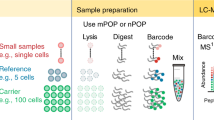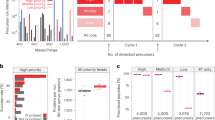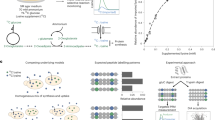Abstract
Non-cell-autonomous proteins are incorporated into cells that form tight contacts or are invaded by bacteria, but identifying the full repertoire of transferred proteins has been a challenge. Here we introduce a quantitative proteomics approach to sort out non-cell-autonomous proteins synthesized by other cells or intracellular pathogens. Our approach combines stable-isotope labeling of amino acids in cell culture (SILAC), high-purity cell sorting and bioinformatics analysis to identify the repertoire of relevant non-cell-autonomous proteins. This 'trans-SILAC' method allowed us to discover many proteins transferred from human B to natural killer cells and to measure biosynthesis rates of Salmonella enterica proteins in infected human cells. Trans-SILAC should be a useful method to examine protein exchange between different cells of multicellular organisms or pathogen and host.
This is a preview of subscription content, access via your institution
Access options
Subscribe to this journal
Receive 12 print issues and online access
$259.00 per year
only $21.58 per issue
Buy this article
- Purchase on Springer Link
- Instant access to full article PDF
Prices may be subject to local taxes which are calculated during checkout




Similar content being viewed by others
References
Mazzarello, P. A unifying concept: the history of cell theory. Nat. Cell Biol. 1, E13–E15 (1999).
Rechavi, O., Goldstein, I. & Kloog, Y. Intercellular exchange of proteins: the immune cell habit of sharing. FEBS Lett. 583, 1792–1799 (2009).
Davis, D.M. Intercellular transfer of cell-surface proteins is common and can affect many stages of an immune response. Nat. Rev. Immunol. 7, 238–243 (2007).
Huang, J.F. et al. TCR-Mediated internalization of peptide-MHC complexes acquired by T cells. Science 286, 952–954 (1999).
Joly, E. & Hudrisier, D. What is trogocytosis and what is its purpose? Nat. Immunol. 4, 815 (2003).
Sprent, J. Swapping molecules during cell-cell interactions. Sci. STKE 2005, pe8 (2005).
Hudrisier, D., Aucher, A., Puaux, A.L., Bordier, C. & Joly, E. Capture of target cell membrane components via trogocytosis is triggered by a selected set of surface molecules on T or B cells. J. Immunol. 178, 3637–3647 (2007).
Rechavi, O., Goldstein, I., Vernitsky, H., Rotblat, B. & Kloog, Y. Intercellular transfer of oncogenic H-Ras at the immunological synapse. PLoS ONE 2, e1204 (2007).
McCann, F.E., Eissmann, P., Onfelt, B., Leung, R. & Davis, D.M. The activating NKG2D ligand MHC class I-related chain A transfers from target cells to NK cells in a manner that allows functional consequences. J. Immunol. 178, 3418–3426 (2007).
LeMaoult, J. et al. Immune regulation by pretenders: cell-to-cell transfers of HLA-G make effector T cells act as regulatory cells. Blood 109, 2040–2048 (2007).
Daubeuf, S. et al. Preferential transfer of certain plasma membrane proteins onto T and B cells by trogocytosis. PLoS ONE 5, e8716 (2010).
Shames, S.R., Auweter, S.D. & Finlay, B.B. Co-evolution and exploitation of host cell signaling pathways by bacterial pathogens. Int. J. Biochem. Cell Biol. 41, 380–389 (2009).
Vanherberghen, B. et al. Human and murine inhibitory natural killer cell receptors transfer from natural killer cells to target cells. Proc. Natl. Acad. Sci. USA 101, 16873–16878 (2004).
Ong, S.E. et al. Stable isotope labeling by amino acids in cell culture, SILAC, as a simple and accurate approach to expression proteomics. Mol. Cell. Proteomics 1, 376–386 (2002).
Ong, S.E., Foster, L.J. & Mann, M. Mass spectrometric-based approaches in quantitative proteomics. Methods 29, 124–130 (2003).
Cox, J. & Mann, M. MaxQuant enables high peptide identification rates, individualized p.p.b.-range mass accuracies and proteome-wide protein quantification. Nat. Biotechnol. 26, 1367–1372 (2008).
Dennis, G., Jr. et al. DAVID: database for annotation, visualization, and integrated discovery. Genome Biol. 4, 3 (2003).
Daubeuf, S., Puaux, A.L., Joly, E. & Hudrisier, D. A simple trogocytosis-based method to detect, quantify, characterize and purify antigen-specific live lymphocytes by flow cytometry, via their capture of membrane fragments from antigen-presenting cells. Nat. Protoc. 1, 2536–2542 (2006).
Hansen-Wester, I. & Hensel, M. Salmonella pathogenicity islands encoding type III secretion systems. Microbes Infect. 3, 549–559 (2001).
Rafii, A. et al. Oncologic trogocytosis of an original stromal cells induces chemoresistance of ovarian tumours. PLoS ONE 3, e3894 (2008).
Rustom, A., Saffrich, R., Markovic, I., Walther, P. & Gerdes, H.H. Nanotubular highways for intercellular organelle transport. Science 303, 1007–1010 (2004).
Gousset, K. et al. Prions hijack tunnelling nanotubes for intercellular spread. Nat. Cell Biol. 11, 328–336 (2009).
Rechavi, O. et al. Cell contact-dependent acquisition of cellular and viral nonautonomously encoded small RNAs. Genes Dev. 23, 1971–1979 (2009).
Domaica, C.I. et al. Tumour-experienced T cells promote NK cell activity through trogocytosis of NKG2D and NKp46 ligands. EMBO Rep. 10, 908–915 (2009).
Tabiasco, J. et al. Acquisition of viral receptor by NK cells through immunological synapse. J. Immunol. 170, 5993–5998 (2003).
Goldstein, I. et al. alpha1beta1 Integrin+ and regulatory Foxp3+ T cells constitute two functionally distinct human CD4+ T cell subsets oppositely modulated by TNFalpha blockade. J. Immunol. 178, 201–210 (2007).
Mortensen, P. et al. MSQuant, an open source platform for mass spectrometry-based quantitative proteomics. J. Proteome Res. 9, 393–403 (2009).
Rogers, L.D. & Foster, L.J. The dynamic phagosomal proteome and the contribution of the endoplasmic reticulum. Proc. Natl. Acad. Sci. USA 104, 18520–18525 (2007).
Chan, Q.W., Howes, C.G. & Foster, L.J. Quantitative comparison of caste differences in honeybee hemolymph. Mol. Cell. Proteomics 5, 2252–2262 (2006).
Lu, P., Vogel, C., Wang, R., Yao, X. & Marcotte, E.M. Absolute protein expression profiling estimates the relative contributions of transcriptional and translational regulation. Nat. Biotechnol. 25, 117–124 (2007).
Acknowledgements
O.R. was supported by a scholarship from the Clore Israel Foundation. M.K. was supported by the Edmond J. Safra Program in Bioinformatics at Tel Aviv University. Operating funds for this work came, in part, from the Prajs-Drimmer Institute for the Development of Anti-degenerative Disease Drugs to Y.K., from the Israel Cancer Association to I.G. and Y.K. and from a Canadian Institutes of Health Research Operating grant (MOP-77688) to L.J.F. Mass spectrometry infrastructure used in this project was supported by the Canadian Foundation for Innovation, the British Columbia Knowledge Development Fund and the British Columbia Proteomics Network. Y.F. is supported by a studentship from the Genome Sciences and Technologies graduate program. Expression vectors encoding for EGFP-tagged RALA and RALB proteins were a gift from A. Cox (The University of North Carolina at Chapel Hill) and vectors for Arf4, Rab10 and Rab11a were a gift from D. Cassel (Technion, Israel Institute of Technology).
Author information
Authors and Affiliations
Contributions
O.R. jointly conceived the study with I.G., designed experiments, performed experiments, analyzed data and wrote the paper; M.K. developed analytical tools and analyzed data; Y.F. designed and performed experiments and analyzed data; H.V. performed experiments and analyzed data; J.J.-H. analyzed data; L.J.F. designed experiments, developed analytical tools, analyzed data and wrote the paper; Y.K. and I.G. jointly supervised the project, designed experiments, analyzed data and wrote the paper.
Corresponding authors
Ethics declarations
Competing interests
The authors declare no competing financial interests.
Supplementary information
Supplementary Text and Figures
Supplementary Figures 1–8, Supplementary Tables 3–5 (PDF 3283 kb)
Supplementary Table 1
Raw trans-SILAC data. (XLS 1145 kb)
Supplementary Table 2
All spectral counts. (XLS 566 kb)
Supplementary Table 6
Bacterial intracellular protein synthesis during early Salmonella invasion. (XLS 200 kb)
Supplementary Software
The in-house Perl and R scripts used to process the datasets and a readme file with detailed instructions for sorting out the positive hits. (ZIP 5846 kb)
Rights and permissions
About this article
Cite this article
Rechavi, O., Kalman, M., Fang, Y. et al. Trans-SILAC: sorting out the non-cell-autonomous proteome. Nat Methods 7, 923–927 (2010). https://doi.org/10.1038/nmeth.1513
Received:
Accepted:
Published:
Issue Date:
DOI: https://doi.org/10.1038/nmeth.1513
This article is cited by
-
Plant and animal small RNA communications between cells and organisms
Nature Reviews Molecular Cell Biology (2022)
-
Extracellular NK histones promote immune cell anti-tumor activity by inducing cell clusters through binding to CD138 receptor
Journal for ImmunoTherapy of Cancer (2019)
-
A draft network of ligand–receptor-mediated multicellular signalling in human
Nature Communications (2015)
-
Chemical Tools for Temporally and Spatially Resolved Mass Spectrometry-Based Proteomics
Annals of Biomedical Engineering (2014)
-
H-Ras transfers from B to T cells via tunneling nanotubes
Cell Death & Disease (2013)



